FETA WITH HONEY + HERBS
Three Spring Things: Two easy ways to serve Feta, daffodil colored cookbooks, and agrodolce everything!
Welcome!! ~ This is a reader supported publication. Upgrade to paid below for full access to complete recipe archives, travel guides, and more. ♡ Other ways to support my work? Buy my books, like, comment and forward this post to a friend.
Hello!
It’s officially Spring. It’s raining on/off all week, and I’m incubating after a weekend of celebrating Mátyás’ tenth birthday in every possible way (at school, with friends, with family). There were bike rides, ski dates, sushi dinners, Oreos, chocolate cake, and many screaming little boys inside my house. I loved every minute (err, almost every minute!!)
I didn’t write last week, so look for two letters this week, with delicious, refreshing ideas to jump-start your spring season. The first takes a page from the
School of Three Things (if you haven’t read her newsletter yet, head over there next!). The second will help you lean into all the green things that light our inner fires as we come out of hibernation.I’m keeping my intro short and sweet this week: everything you need to know is in the notes below. Thank you, as always, for reading.
xx
Sarah
This letter wouldn’t be possible without YOU! Thank you for being here and enormous thanks to all who choose to support my work with a paid subscription.
AN EASY WAY TO SERVE FETA
My daughter and I love Feta. I’ve shared about our love for Greek Salad before, but when a good piece of Feta comes into the house (Greek, French, or Bulgarian—they all make high-quality Sheep’s Milk Feta-style cheese), sometimes you want to let it stand alone, with some classy embellishments. The trick is to buy Feta in slabs, ideally floating in a brine, never pre-cubed or crumbled. Next, give it some love on a small platter or shallow bowl with a glug of good olive oil and a drizzle of your finest honey. Sprinkle with Maldon Salt and fresh herbs. If you have access to honeycomb or chunky, homemade marmalade, you can dollop those on top, too, to take this to the sweeter side. Or go savory with chopped olives and capers (see below), piquillo peppers, and red pepper flakes. Both versions are excellent, served alongside scrambled eggs and toast or crackers at breakfast or brunch, or with giant bowls of greens/grains for crumbling Feta over.
Of course, you can wrap Feta in brie, bake Feta with citrust and olives (here’s my best recipe), broil Feta, or even confit Feta in oil with peppers, olives, and capers—all excellent choices, but don’t overlook this quick fix for when you want to start a meal with cheese (lowercase) without starting the meal with CHEESE (uppercase).
SUNNY BOOKS (and other kitchen things!)
When I worked at Food Network (throughout my mid-to-late twenties), I was obsessed with all things yellow. I had yellow kitchen clogs and yellow posters on the wall, and every last of the rubber spatulas in my station at work was a buttery, daffodil yellow. It’s a color that gives me so much energy.
I’ve since migrated to other palettes, but today, while leafing through
The Farm Table, one of my favorite cookbooks for Spring, I realized that more than a dozen beloved books from over the years share this daffodil-colored cover/spine (they all live together in one section of my bookcase in my office): Hemsley and Hemsley’s The Art of Eating Well, Nigel Slater’s EAT, Al Fresco, by Julie Pointer Adams, That Sounds So Good by , and Bright Cooking by , to name a few.The pages of these books are filled with recipe titles like Young Turnips with Mushrooms and Orzo, Spiced Haddock Chowder, Chicken with Artichokes, Spring Garlic Tart, Brothy Basil Beans, Ham Hock, Pea and Mint Stew, Anchovy Crema and Radishes—words that get you in the mood for spring produce. Trust—many of these authors also happen to be British, and British cooks crush it with Spring produce. (I’m making the Potato and Taleggio Galette from Robert’s book—pictured above— for this weekend’s cookbook club; I’ll report back!)
If your bookshelves are overloaded, there are many other ways to bring a spot of sunshine to your kitchen: a lemony citrus reamer (or flat juice press), golden curtains, a ruffled pillow, mustard napkins, yuzu colored breakfast bowls, or bright and bold kitchen sconces. Also, olive oil! Be lavish—let it pool on the plate, over vegetables, and on your favorite crusty bread. Until the rain clears, it feels like stored sunshine.
AGRODOLCE, EVERYTHING!
We have a million things to thank Italians for. One of my favorites is agrodolce, a sweet and sour sauce made with vinegar, olive oil, and often raisins, capers, or green olives, among other things. It’s brilliant on roasted cauliflower, steamed broccoli, seared fish, a bavette/steak, and even Feta (a full circle moment!). Or, add it to a basic cream cheese bagel, as you see above, for an element of surprise (I made this for a recent weekend brunch with friends—a delight!).
Agrodolce is a beautiful trick to keep in your back pocket for shoulder season. Say it’s rainy and cold one day—drizzle your agrodolce over roasted butternut or spaghetti squash! When the sun shines, spoon agrodolce on grilled or seared swordfish, sea bass, or bitter greens, like chicories. It won’t let you down. Here’s a simple recipe:
Ingredients (musts)
3 tablespoons extra virgin olive oil
1 shallot or small onion, minced or thinly sliced*
1/2 cup red wine or balsamic vinegar
2 tablespoons capers or chopped green olives
1/3 to 1/2 cup golden or dark raisins
3 to 4 tablespoons maple syrup
Maldon salt and freshly ground black pepper
2 tablespoons chopped herbs such as thyme or parsley
Optional Ingredients (see note!)*
1/4 cup toasted pine nuts
1 tablespoon lemon zest
hearty pinch red pepper flakes (to taste)
Instructions
Heat a small saucepan over medium heat and add the olive oil. Add the shallots and cook slowly until they become soft and slightly brown— 5 to 8 minutes. Add the vinegar and simmer until the liquid reduces by half, about 5 minutes.
Add the capers/olives, raisins, pine nuts, and any optional ingredients as desired. Stir in the maple syrup and simmer for 2 to 3 minutes more to thicken. Season with (Maldon) salt and pepper and finish with fresh herbs.
*COOK’S NOTE: You’ll find traditional Sicilian Agrodolce recipes with varying ingredients, most often using sliced onion. Some are looser and some cooked down and packed with raisins, pine nuts, and bigger, meaty olives. I like my agrodolce fresh and loose, as seen above on a the bagel; sometimes I even skip the shallot/onion, which makes it easy to drizzle. But if you want a sauce that holds up to a hearty piece of steak, chicken or fish, more is more. Go for all the extras you crave.
Photos and styling by Sarah Copeland

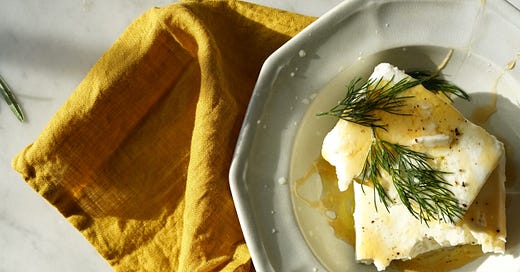




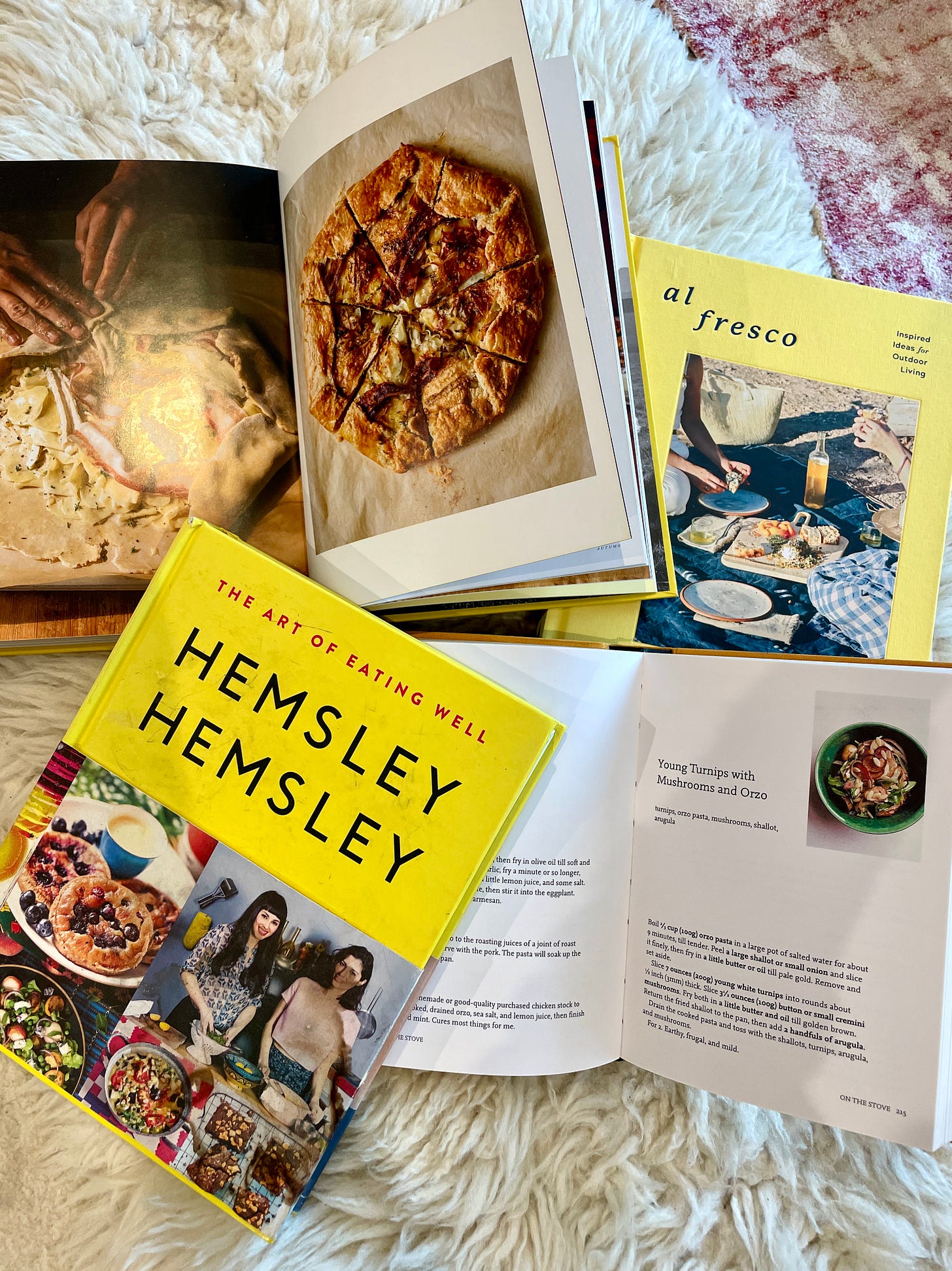
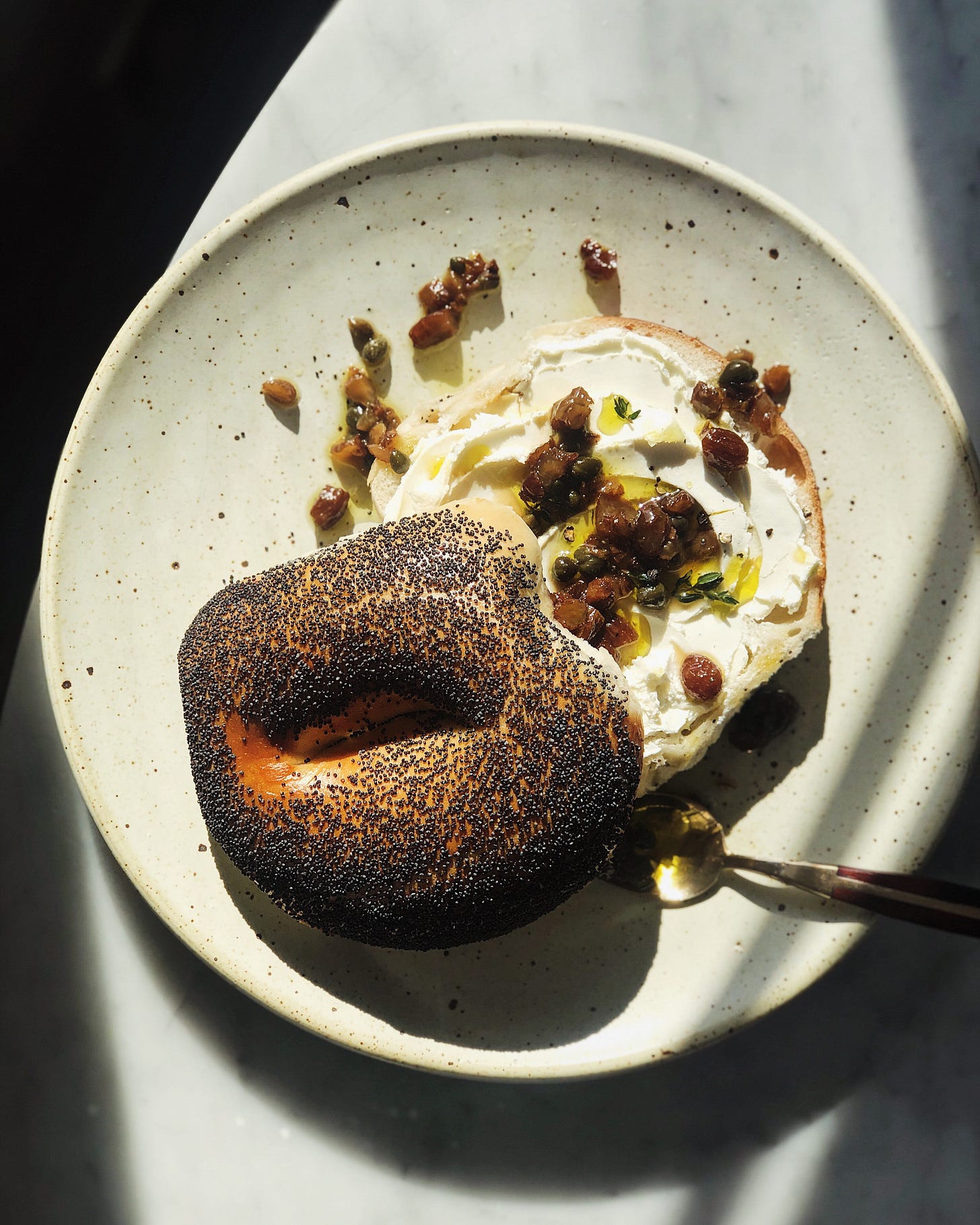

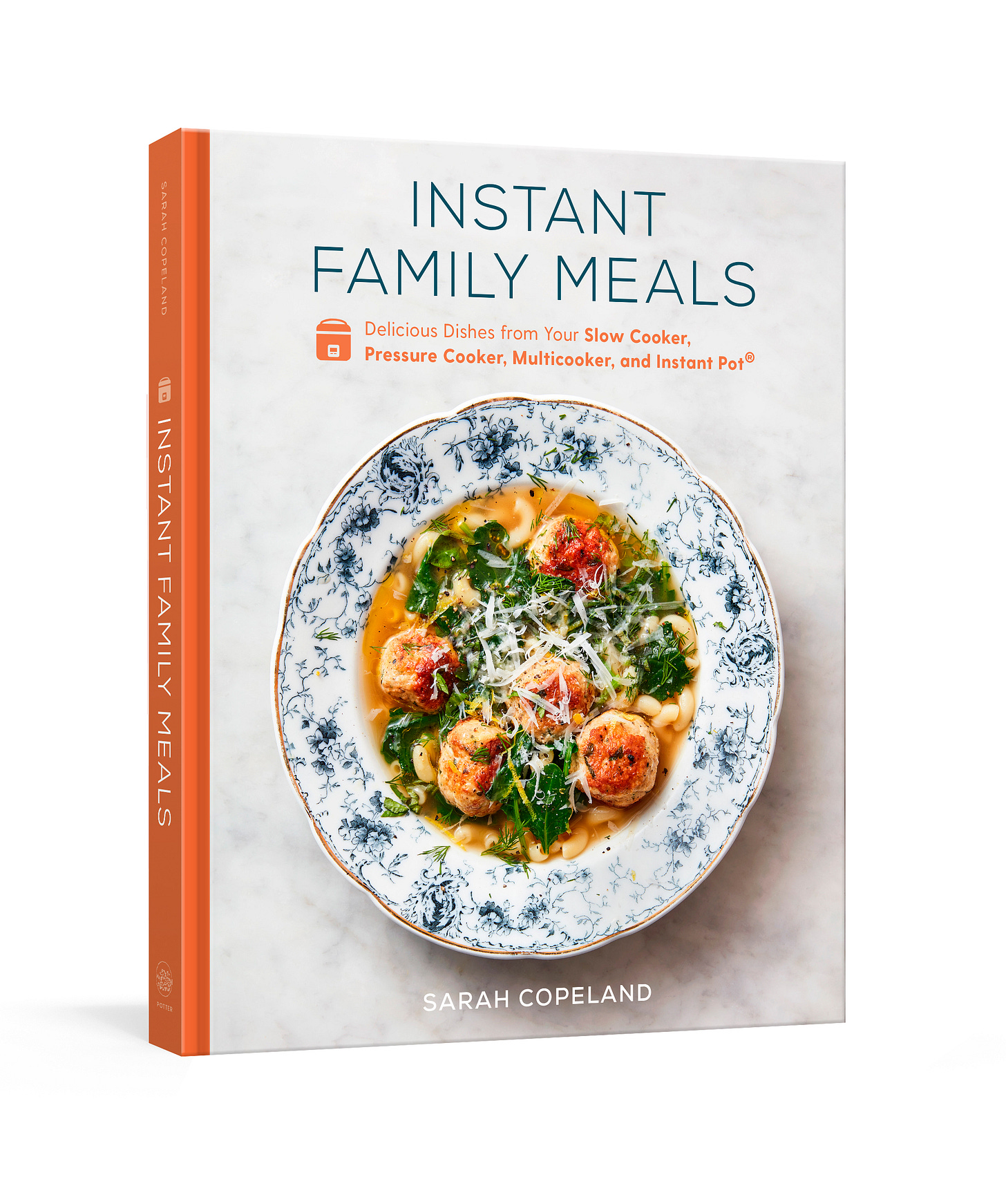
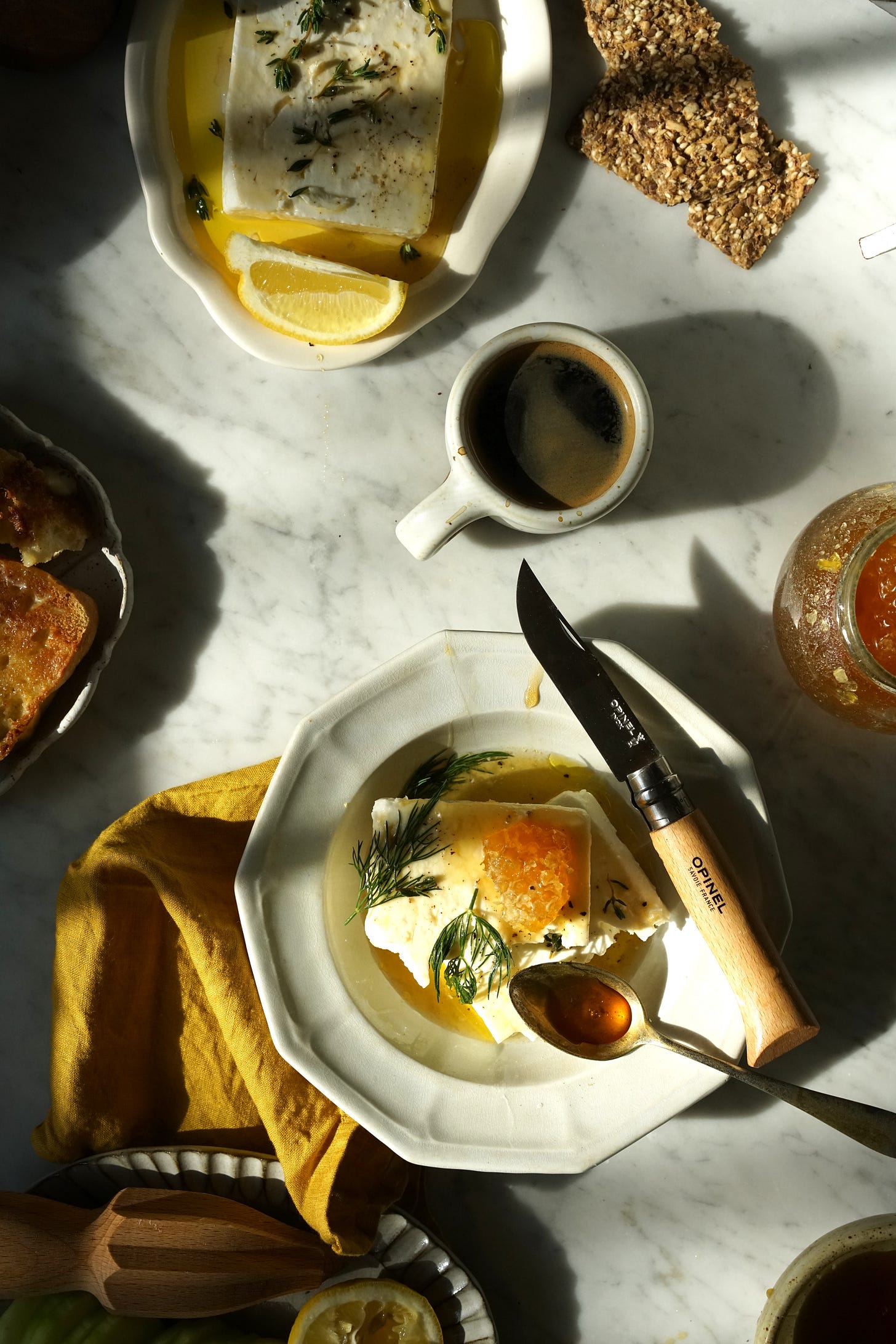
Ooh, commenting on my own post to call out more buttery/daffodil yellow spring thing that is bringing joy right now: Mango Lassis. I'm sipping one right now while I write. Let me know if you all want my easy go-to recipe. (I make them 1 x a week for my kids).
Sarah, you always put together the most beautiful food moments! I went through a serious phase once of eating chunks of feta on sourdough topped with walnuts and a drizzle of honey every day. You've inspired me to revisit it!!